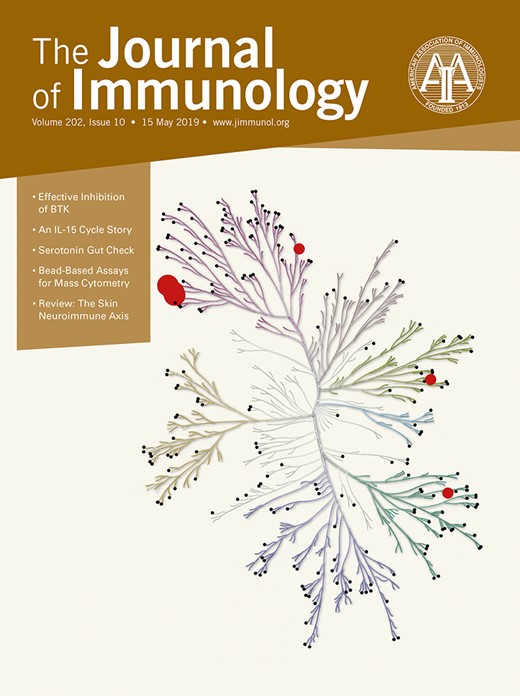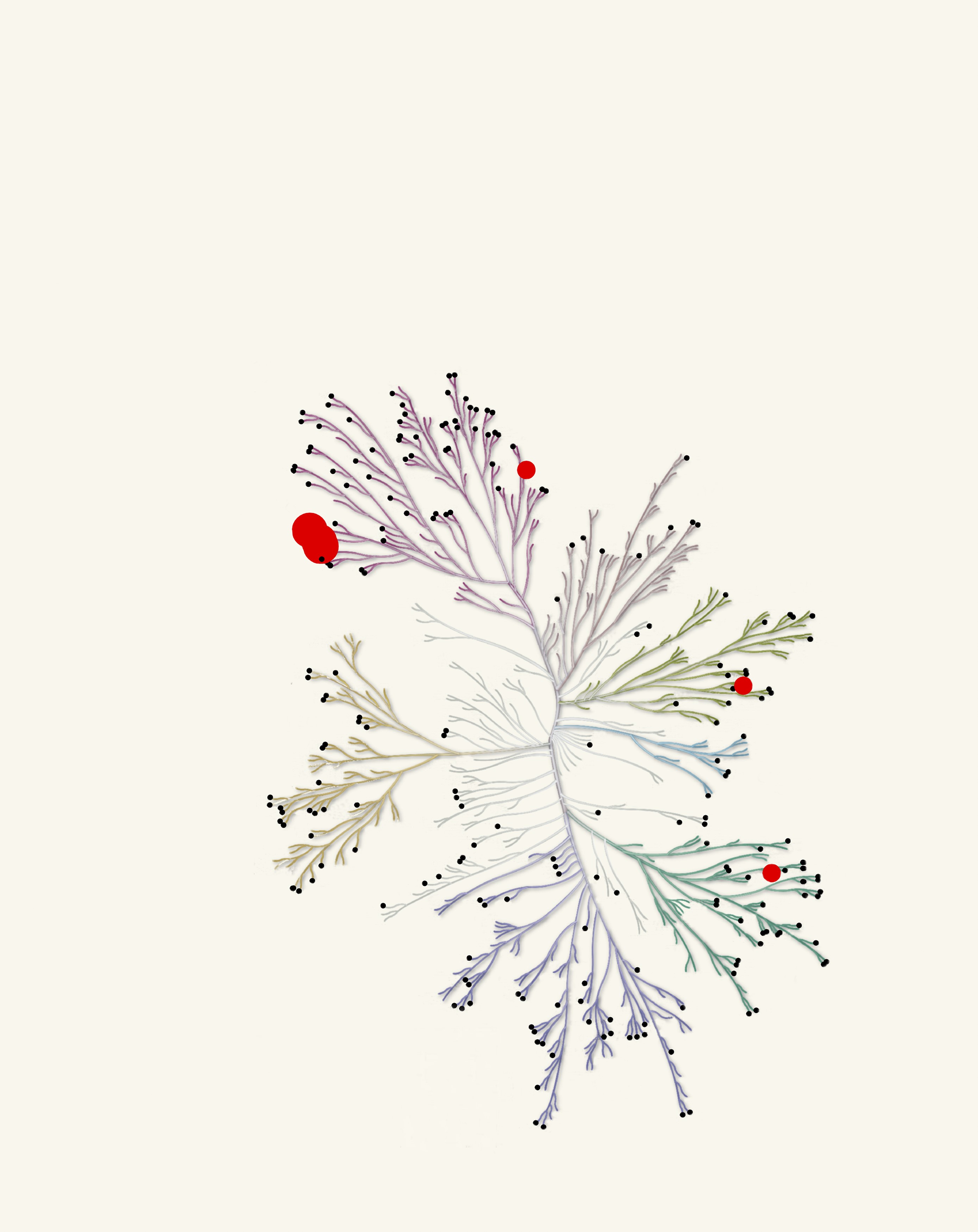
Cover image

On the cover: Selectivity of evobrutinib as determined in a KinaseProfiler screen. Results are shown in a kinome tree format. Red circles depict inhibition of a tested kinase, whereas black dots depict no inhibition. Haselmayer, P., M. Camps, L. Liu-Bujalski, N. Nguyen, F. Morandi, J. Head, A. O'Mahony, S. C. Zimmerli, L. Bruns, A. T. Bender, P. Schroeder, and R. Grenningloh. 2019. Efficacy and pharmacodynamic modeling of the BTK inhibitor evobrutinib in autoimmune disease models. J. Immunol. 202: 2888–2906.
Volume 202, Issue 10, May 2019
In This Issue
In This Issue
Immunology Notes and Resources
Report on the 2018 Cancer, Autoimmunity, and Immunology Conference
Brief Reviews
The Neuroimmune Axis in Skin Sensation, Inflammation, and Immunity
Cutting Edge
Cutting Edge: Lymphomyeloid-Primed Progenitor Cell Fates Are Controlled by the Transcription Factor Tal1
Tal1 limits the number of ST-HSC priming lymphoid genes.
Tal1 limits the number of Rag2-GFP+ LMPPs.
Tal1 restrains the frequency of T lymphocyte–biased LMPPs.
Cutting Edge: Polymicrobial Sepsis Has the Capacity to Reinvigorate Tumor-Infiltrating CD8 T Cells and Prolong Host Survival
CLP-induced polymicrobial sepsis has the capacity to attenuate tumor growth.
Sepsis reinvigorates tumor-infiltrating CD8 T cells.
Checkpoint blockade after sepsis further improves survival of tumor-bearing hosts.
Antigen Recognition and Responses
Upstream Position of Proline Defines Peptide–HLA Class I Repertoire Formation and CD8+ T Cell Responses
Proteomics analysis shows the upstream proline signature of HLA class I ligands.
Proline at upstream positions 1–3 attenuates CTL responses to a downstream epitope.
The finding contributes to prediction of naturally presented CTL epitopes.
The Activation State of CD4 T Cells Alters Cellular Peptidase Activities, HIV Antigen Processing, and MHC Class I Presentation in a Sequence-Dependent Manner
Trogocytosis-Mediated Intracellular Signaling in CD4+ T Cells Drives TH2-Associated Effector Cytokine Production and Differentiation
Trogocytosis-mediated signaling promotes IL-4 expression and TH2 differentiation.
TH2 cells perform trogocytosis more efficiently than TH1 or nonpolarized cells.
In vivo–generated, trogocytosis-positive cells are predominantly TH2.
Autoimmunity
Efficacy and Pharmacodynamic Modeling of the BTK Inhibitor Evobrutinib in Autoimmune Disease Models
The covalent BTK inhibitor evobrutinib blocks B cell and myeloid cell activation.
Evobrutinib is efficacious in mouse models for RA, SLE, and cutaneous anaphylaxis.
Covalent binding allows modeling the relationship between BTK occupancy and efficacy.
Nur77 Links Chronic Antigen Stimulation to B Cell Tolerance by Restricting the Survival of Self-Reactive B Cells in the Periphery
Nur77 expression correlates with the degree of autoreactivity of individual B cells.
Nur77 is dispensable for receptor editing, central deletion, and anergy.
Nur77 restrains the survival of mature self-reactive B cells.
Clinical and Human Immunology
Mechanism for IL-15–Driven B Cell Chronic Lymphocytic Leukemia Cycling: Roles for AKT and STAT5 in Modulating Cyclin D2 and DNA Damage Response Proteins
TLR9-primed human B-CLL clones respond to IL-15 with AKT and STAT5 activation.
PI3K/AKT and STAT5 pathways elevate cyclin D2 and repress ATM, TP53BP1, and MDC1.
Inhibitors of PI3K or STAT5 block in vitro B-CLL cycling induced by CpG DNA and IL-15.
Immune Pharmacodynamic Responses of the Novel Cancer Immunotherapeutic Imprime PGG in Healthy Volunteers
The pharmacological activity of Imprime is dependent on naturally occurring serum ABA.
A threshold of IgG ABA is necessary for Imprime-mediated innate immune responses.
It is likely that high-ABA subjects will be more prone to infusion-related reactions.
Immune Regulation
The Otubain YOD1 Suppresses Aggregation and Activation of the Signaling Adaptor MAVS through Lys63-Linked Deubiquitination
The otubain YOD1 fine-tunes MAVS-RLR pathway–mediated antiviral immunity.
YOD1 interacts with MAVS on mitochondria.
YOD1 deubiquitinates MAVS and abrogates aggregation of MAVS.
Regulation of Phospholipase D by Arf6 during FcγR-Mediated Phagocytosis
Arf6 partially colocalized with PLD1 on vesicles and with PLD2 at the plasma membrane.
Active Arf6 is recruited to nascent phagosomes.
Arf6 regulates PLD activity and PA synthesis during phagocytosis.
Deletion of Biliverdin Reductase A in Myeloid Cells Promotes Chemokine Expression and Chemotaxis in Part via a Complement C5a–C5aR1 Pathway
Myeloid-specific conditional deletion of BVR-A results in increased response to LPS.
Macrophages isolated from LysM-Cre:BVRfl/fl showed elevated levels of C5aR1.
Deletion of BVR-A resulted in enhanced macrophage chemotaxis toward C5a.
BVR-A–modulated chemotaxis and RANTES levels are dependent in part on C5aR1.
Bach2 Negatively Regulates T Follicular Helper Cell Differentiation and Is Critical for CD4+ T Cell Memory
Bach2 deletion in CD4+ T cells results in preferential Tfh cell differentiation.
The CXCR5 induction in the absence of Bach2 occurs before the upregulation of Ascl2.
Bach2 is critical for CD4+ T cell memory, including Tfh cell memory.
Langerhans Cells Control Lymphatic Vessel Function during Inflammation via LIGHT-LTβR Signaling
LCs express LIGHT, and chimeras lacking LIGHT in LCs have reduced skin DC migration.
Lymphatic endothelial cell–specific LTβR is required for skin DC migration.
LIGHT-LTβR signaling axis activates lymphatic endothelial CCL21/CCL19 expression.
Immune System Development
Malt1 Protease Is Critical in Maintaining Function of Regulatory T Cells and May Be a Therapeutic Target for Antitumor Immunity
Malt1 is required for the development and function of Treg cells.
Malt1 protease activity in Treg cells could be a target for tumor therapy.
Innate Immunity and Inflammation
Trauma Induces Emergency Hematopoiesis through IL-1/MyD88–Dependent Production of G-CSF
Traumatic injury alone without infection can induce emergency hematopoiesis.
Trauma induces emergency hematopoiesis through IL-1 -dependent production of G-CSF.
GM-CSF– and IRF4-Dependent Signaling Can Regulate Myeloid Cell Numbers and the Macrophage Phenotype during Inflammation
ZIP requires GM-CSF and IRF4 signaling.
The ZIP macrophage phenotype is altered by a lack of GM-CSF or IRF4.
GM-CSF–IRF4 signaling upregulated MHCII expression in ZIP macrophages.
ZIP is independent of CCL17.
Mucosal Immunology
TLR2 Plays a Pivotal Role in Mediating Mucosal Serotonin Production in the Gut
TLR2 plays a key role in gut serotonin production by both resident microbiota and a parasite.
TLR2 in nonhematopoietic cells is largely responsible for serotonin production in the gut.
We show TLR2 signaling–based novel mechanism of serotonin production in the gut.
Transplantation
ST2/MyD88 Deficiency Protects Mice against Acute Graft-versus-Host Disease and Spares Regulatory T Cells
MyD88 deficiency in donor Tcons with Tregs protected against alloreactivity and aGVHD.
This protective effect uses ST2 but not the IL-1R or TLR4 pathways.
Tumor Immunology
FGFR2 Promotes Expression of PD-L1 in Colorectal Cancer via the JAK/STAT3 Signaling Pathway
Progesterone Receptor Attenuates STAT1-Mediated IFN Signaling in Breast Cancer
PR interacts with STAT1 in breast cancer cells.
PR attenuates IFN-induced STAT1 phosphorylation in breast cancer.
IFN signaling via STAT1 is more robust in breast cancer cells lacking PR.
The Angiotensin Receptor Blocker Losartan Suppresses Growth of Pulmonary Metastases via AT1R-Independent Inhibition of CCR2 Signaling and Monocyte Recruitment
Losartan blocks CCL2–CCR2 monocyte recruitment to suppress lung metastasis growth.
Losartan functionally antagonizes CCL2–CCR2 ERK activation, independent of its AT1R target.


